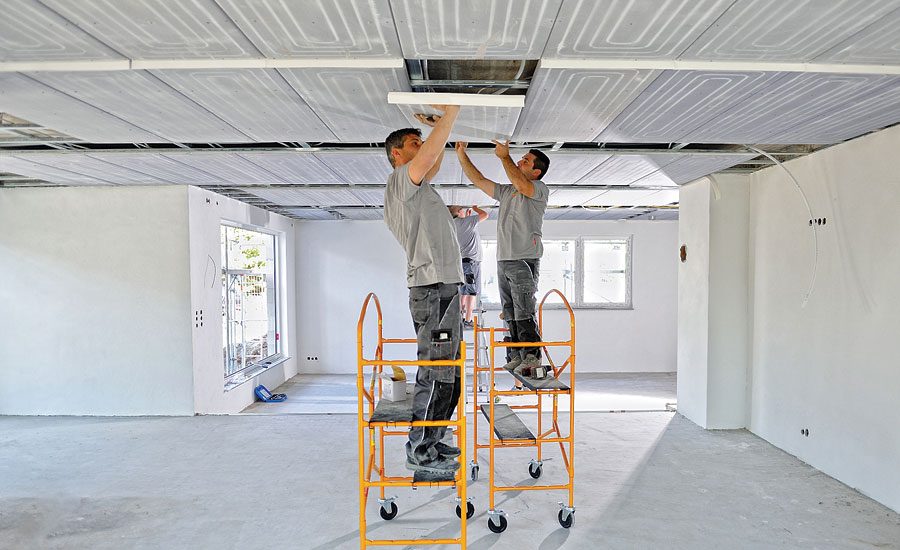Radiant ceilings offer options for heritage homes and other buildings
Looking up to heating systems.

As with radiant floor heating, a radiant ceiling uses the same three types of heat transfer: conduction, radiation and convection. Photo credit: Uponor

The coefficient of radiant ceiling heat is about 1.1 Btuh per sq. ft. per degree Fahrenheit difference between the ceiling surface temperature and the room setpoint temperature.


When most of us think about hydronic radiant systems, usually heated floor and radiators and radiators spring to mind. However, another surface can be used to keep a room comfortable: radiant ceilings.
As with radiant floor heating, a radiant ceiling uses the same three types of heat transfer: conduction, radiation and convection.
Heat radiation from a ceiling system will warm room surfaces, furnishings and floors. Those surfaces then provide secondary transfer through conduction (direct contact) and re-radiation. When people walk across the floor or touch a table that is warm as a result of heat radiation, some of that heat is transferred to them. That’s conduction.
The effect of conduction with a radiant ceiling is less than that of a radiant floor, but for projects where it is not desirable, or possible, for the floor to be disturbed, it does provide an interesting solution.
A great example of using radiant ceilings would be in heritage homes where the original hardwood or tiled floors must be maintained for their character or to stay true to the history of the structure. Installing radiant in the ceilings can be a fairly clean installation method, with minimal disruption to the original structure. Stucco or plaster ceiling designs can often be replicated to match the original style used in the room.
The thermal transfer coefficient of radiant ceiling heat takes into account the transfer of heat energy due to convection and radiation. The coefficient of radiant ceiling heat is about 1.1 Btuh per sq. ft. per degree Fahrenheit difference between the ceiling surface temperature and the room setpoint temperature. With radiant floors, the heat transfer coefficient is 2.0.
Being a low-mass system using highly conductive gypsum Sheetrock, radiant ceilings are very responsive and are suitable for surface temperatures as high as 100° F with normal 8-ft. ceilings. Surfaces can go up to 110° for ceilings higher than 8 ft. but lower than 12 ft. Radiant ceilings typically operate on water temperatures no higher than 120°.
Where ceiling height is a concern, using the ceiling for radiant may help, since radiant ceiling heating systems typically require only 1 1/2 in. of height, making it possible to retrofit a heating system into a space with minimal impact on the room dimensions.
One of the biggest advantages radiant ceiling panels offer is that they are not subject to changes in floor coverings or use patterns, so swapping a carpet for a tile or laminate floor will not require a reconfiguration of the heating system.
Design considerations
Unlike radiant floor heating, floor coverings are not a concern with radiant ceilings, and the surface temperature limitations are higher. The exception is when a radiant ceiling is installed over an uninsulated concrete slab. In this case, using a high R-value floor covering may be beneficial.
A ceiling system for heating is not recommended if the room is to have uninsulated, bare concrete floors because the concrete floor will never feel truly warm for the occupant’s feet. The lack of insulation under the slab will cause too much heat to be lost to the ground below. For occupants of the space, an ideal comfort level may never be reached because the floor will always feel cold.
Even with a forced-air heating system, an uninsulated concrete slab in a basement will always be cooler than the air in the space. For uninsulated slabs, floor coverings are always a plus when considering comfort. Carpets or rugs often make the most sense for these types of applications.
A radiant ceiling system can be used as a sole source of heat or as supplemental heat but, as with any heating system, it is important to perform an accurate room-by-room heat-loss analysis using an appropriate indoor design temperature.
Keep in mind it is not always necessary to install tubing over the entire ceiling area. If the Btuh per sq. ft. requirement is low, increasing the load per sq. ft. and concentrating the tubing and plates in the high heat-loss areas of the room can reduce the amount of material required, thus lowering the installed price of the system.
Five performance factors to calculate when designing a hydronic radiant ceiling heating system are:
-
Accurate room-by-room heat-loss analysis;
-
Surface temperature requirements;
-
Supply water temperature requirements;
-
Fluid flow requirements; and
-
Pressure loss.
A matter of comfort
Most people think comfort is a matter of supplying heat to the body. Rather, comfort is controlling the rate at which a body loses heat.
A typical person during normal or light activity loses heat at a rate of about 400 Btuh. That heat energy is lost in three specific ways:
-
The body loses heat through convection, or air currents, passing over the body surface.
This article was originally titled “Looking up to heating systems” in the September 2016 print edition of Plumbing & Mechanical.
Looking for a reprint of this article?
From high-res PDFs to custom plaques, order your copy today!








